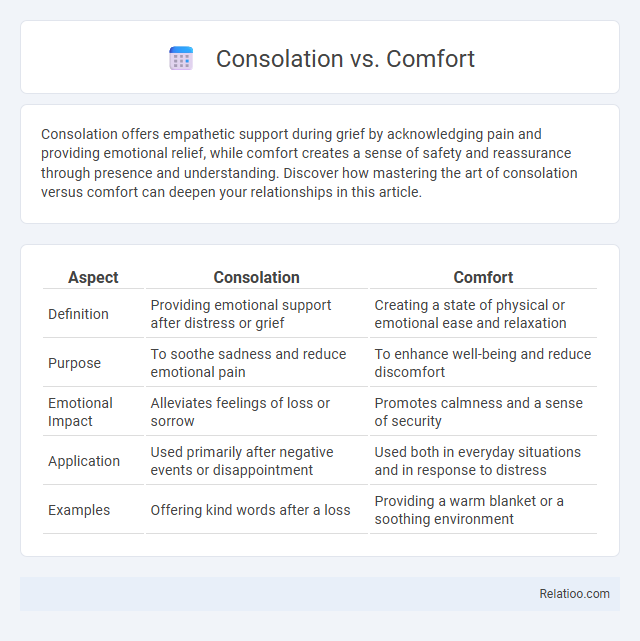Consolation offers empathetic support during grief by acknowledging pain and providing emotional relief, while comfort creates a sense of safety and reassurance through presence and understanding. Discover how mastering the art of consolation versus comfort can deepen your relationships in this article.
Table of Comparison
| Aspect | Consolation | Comfort |
|---|---|---|
| Definition | Providing emotional support after distress or grief | Creating a state of physical or emotional ease and relaxation |
| Purpose | To soothe sadness and reduce emotional pain | To enhance well-being and reduce discomfort |
| Emotional Impact | Alleviates feelings of loss or sorrow | Promotes calmness and a sense of security |
| Application | Used primarily after negative events or disappointment | Used both in everyday situations and in response to distress |
| Examples | Offering kind words after a loss | Providing a warm blanket or a soothing environment |
Defining Consolation and Comfort
Consolation refers to the act of providing solace or relief to someone who is experiencing sorrow or distress, often through empathetic words or gestures. Comfort involves creating a sense of physical or emotional ease, aiming to soothe pain or anxiety through warmth, support, or reassurance. Understanding the distinction between consolation and comfort helps you address emotional needs more effectively by recognizing whether someone requires empathetic acknowledgment or tangible reassurance.
Historical Perspectives on Consolation and Comfort
Historical perspectives on consolation and comfort reveal distinct cultural and philosophical approaches to emotional support and healing. Consolation, rooted in ancient philosophical traditions such as Stoicism and Epicureanism, emphasized rational reflection and moral encouragement to alleviate suffering, while comfort often involved more immediate, tactile, and empathetic care practices within religious and social contexts. Understanding these differences can deepen your appreciation of how societies have evolved in addressing human distress through both intellectual and emotional means.
Emotional Impact: Consolation vs Comfort
Consolation involves offering solace that directly addresses grief or distress, providing empathetic support that acknowledges the depth of emotional pain. Comfort often includes actions or words that create physical or psychological ease, fostering a sense of safety and reassurance in distressing situations. While both aim to alleviate suffering, consolation tends to focus more on emotional validation, whereas comfort centers on soothing and calming feelings.
Psychological Differences Between Consolation and Comfort
Consolation involves offering empathy and understanding to help You cope with emotional pain, focusing on acknowledgment and validation of feelings. Comfort provides a sense of physical or emotional relief through soothing actions or presence that soothe distress without necessarily addressing the root cause. Psychologically, consolation engages cognitive processes by helping individuals reframe or make sense of their suffering, while comfort primarily targets emotional regulation and stress reduction.
Social Contexts: When to Console vs When to Comfort
In social contexts, consoling someone typically involves acknowledging their pain and offering empathy during moments of loss or grief, providing a sense of emotional validation. Comforting, by contrast, emphasizes creating a calming environment or reassurance to ease anxiety or distress, often through supportive words or physical presence. Understanding when to console versus when to comfort depends on interpreting the emotional needs of the individual, where consolation addresses sorrow and comfort targets ongoing emotional support.
Language and Communication in Consolation and Comfort
Consolation and comfort both serve crucial roles in language and communication by providing emotional support through empathetic dialogue and reassuring expressions. Consolation often involves acknowledging grief or loss, using validating language to help individuals process pain, while comfort focuses on soothing distress through calming words and gestures that promote reassurance. Effective consolation and comfort require active listening, empathetic responses, and culturally sensitive communication to foster emotional healing and connection.
Cultural Variations in Offering Consolation and Comfort
Cultural variations in offering consolation and comfort influence how emotional support is expressed and received in different societies. In some cultures, physical gestures like hugging or touching are common forms of consolation, while in others, verbal expressions or acts of service hold greater significance. Understanding these cultural nuances helps you provide meaningful support that respects individual traditions and enhances emotional healing.
Benefits of Consolation Compared to Comfort
Consolation provides a deeper emotional relief by acknowledging pain and offering empathetic support, which fosters genuine healing and resilience, unlike comfort that primarily offers temporary ease or distraction. The benefits of consolation include validating feelings, promoting emotional growth, and encouraging acceptance, making it a more sustainable form of solace. In contrast, comfort often addresses surface-level distress without addressing underlying emotional needs.
Practical Strategies for Providing Consolation and Comfort
Practical strategies for providing consolation and comfort involve active listening, empathetic responses, and physical presence to address emotional distress effectively. You can offer consolation by validating feelings and sharing supportive words, while comfort is best delivered through gentle touch, reassuring tone, and creating a safe environment. Tailoring these approaches to individual needs ensures meaningful emotional support that fosters healing and resilience.
Choosing the Right Approach: Consolation or Comfort
Choosing the right approach between consolation and comfort depends on Your needs for emotional support; consolation addresses feelings of grief or loss by acknowledging pain and offering empathy, while comfort provides soothing reassurance that alleviates distress without directly engaging the source of sorrow. Understanding whether You require empathetic acknowledgment (consolation) or calming relief (comfort) helps tailor the response effectively. Recognizing these distinctions ensures that emotional support is both meaningful and appropriate to the situation.

Infographic: Consolation vs Comfort
 relatioo.com
relatioo.com